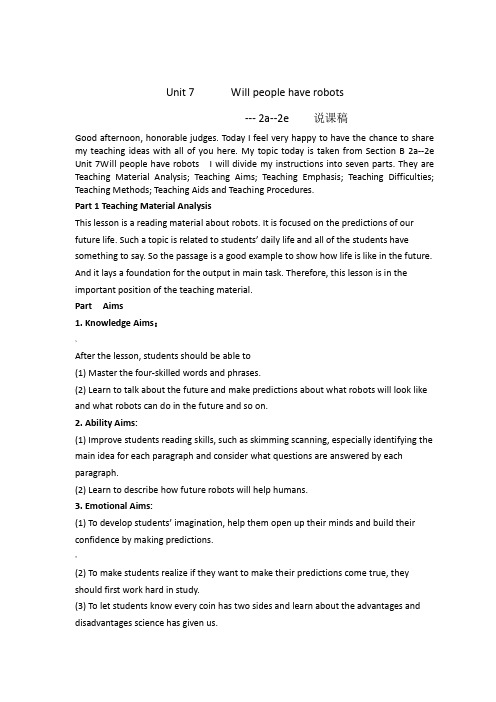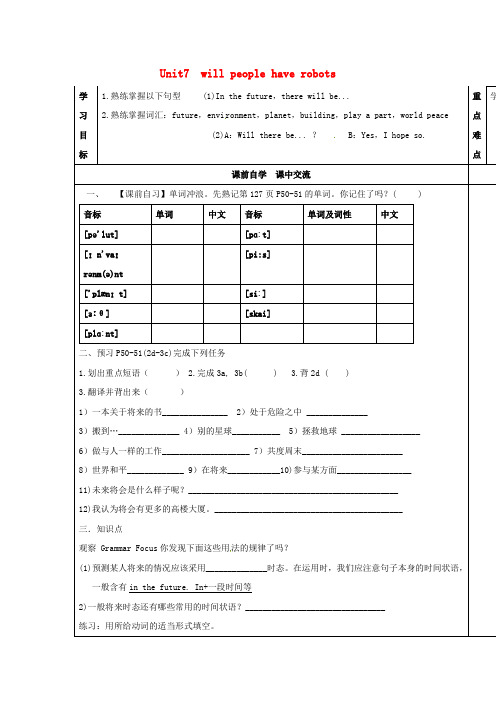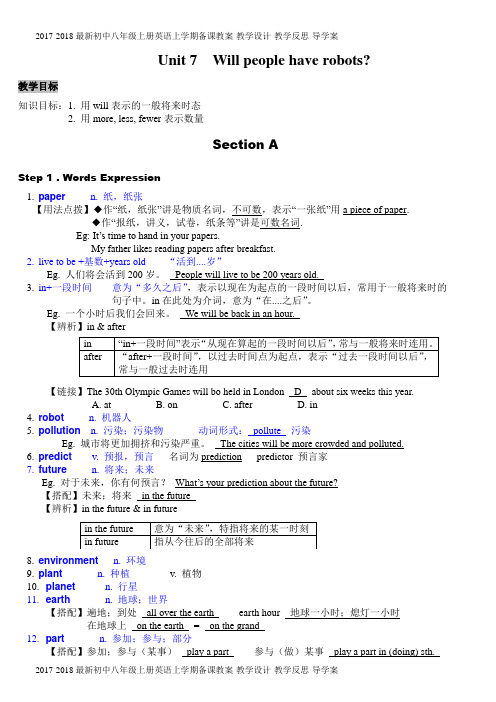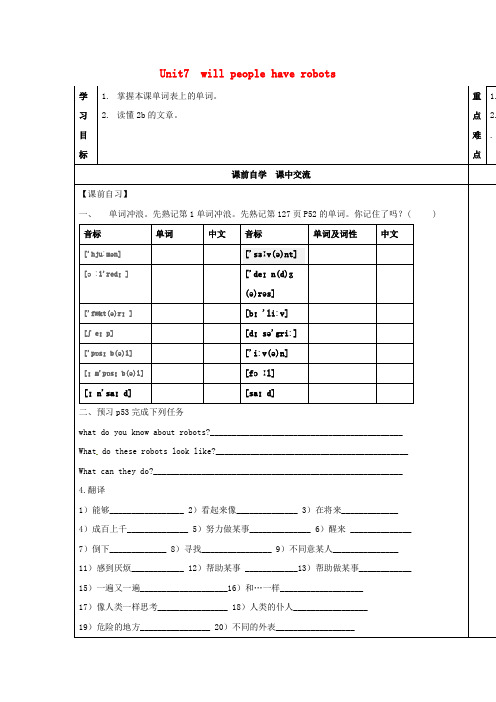2017-2018最新人教版初中八年级上册英语Unit-7-Will-people-have-robots-教案 (3)(15页)
- 格式:doc
- 大小:191.76 KB
- 文档页数:15

Unit 7 Will people have robots--- 2a--2e 说课稿Good afternoon, honorable judges. Today I feel very happy to have the chance to share my teaching ideas with all of you here. My topic today is taken from Section B 2a--2e Unit 7Will people have robots I will divide my instructions into seven parts. They are Teaching Material Analysis; Teaching Aims; Teaching Emphasis; Teaching Difficulties; Teaching Methods; Teaching Aids and Teaching Procedures.Part 1 Teaching Material AnalysisThis lesson is a reading material about robots. It is focused on the predictions of our future life. Such a topic is related to students’ daily life and all of the students have something to say. So the passage is a good example to show how life is like in the future. And it lays a foundation for the output in main task. Therefore, this lesson is in the important position of the teaching material.Part Aims1. Knowledge Aims:~After the lesson, students should be able to(1) Master the four-skilled words and phrases.(2) Learn to talk about the future and make predictions about what robots will look like and what robots can do in the future and so on.2. Ability Aims:(1) Improve students reading skills, such as skimming scanning, especially identifying the main idea for each paragraph and consider what questions are answered by each paragraph.(2) Learn to describe how future robots will help humans.3. Emotional Aims:(1) To develop students’ imagination, help them open up their minds and build their confidence by making predictions.*(2) To make students realize if they want to make their predictions come true, they should first work hard in study.(3) To let students know every coin has two sides and learn about the advantages and disadvantages science has given us.Part3. Teaching Emphasis1. Infer the main idea of the passage according to the title.2. Learn about what robots can do now and what robots will be able to do in the future. Part4. Teaching Difficulties1. Understand some difficult words, phrases and sentences.2. Be able to make predictions about what robots will do in the future.?3. Give opinions about whether it is good for humans to live with a lot of robots in the future.Part5. Teaching Methods1.The method of discussing (讨论法)Discuss what robots look like now and what robots will look like in the future.Discuss what robots can do now and what robots will do in the future.2.The intuitive method of teaching.(直观法)Lead in by a video to arouse students interest.3.The task-based teaching approach(任务型教学方法){The whole teaching process will be carried out by learning and reading tasks. During the process, the students will become the real masters of their learning and reading, while the teacher acts as a director. In this way the learners will experience the knowledge and eventually acquire it.Part 6. Teaching Aids.I will use multi-media(PPT, video), making the class more lively and interesting .I will also use some traditional teaching aids, such as blackboard, cards and chalks.Part7. Teaching ProceduresStep1. Lead- in by showing a video about robots.Lead students discuss what robots look like and what they can do in 2035 according to the video.(Purpose: To stimulate students’ interest and focus students’ attention to the class.At the same time lead in today’s topic.)Step2. While-reading.1. PredictingLook at the title of the passage and the picture on the book page 53. Predict what thepassage is talking about.(Purpose: To develop the ability of predicting what the passage is talking about according to the title and the information appeared in the reading material including the pictures.)2.Fast ReadingSkimmingRead the passage quickly and finish 2b. Then get the main idea of each paragraph. Tips: Reading for meaning, not for details(Purpose: To develop the skills of skimming. And let students read with tasks to improve their reading ability.);3. Careful Reading(1) ScanningRead the passage paragraph by paragraph with different tasks.Read Para. 1, and answer:A. In what kind of movies, we sometimes see robotsB. What are they likeRead Para. 2. complete the sentences.A. Robots can build_____________ in factories.、B. They can do ______jobs many times and not get bored.Read Para. 3 decide True or False.( )1. Some robots in Japan are fun to watch, because they can dance and walk. ( )2 .scientists are trying to make robots look like animals.( )3. we can make robots move like people and think like a human .( )4. Scientist James White believes that robots will never be able to do the same things as we can.Read Para 4. complete the diagram.>—At last make a summary with a mind map.(2) Read with the tape and finish 2d(Purpose: To develop the skills gaining the details of the article. Reading aloud with the tape to correct some pronunciation of the new words and expressions. )Step3. After-reading1.Discussion and performingStudents work in groups to act as some scientists and discuss what will robots help do in the future and whether it is possible for humans to live with robots.[Students show themselves by acting out their conversations.(Purpose: To arouse students’ creativity and imagination. Make them more confident to face the life now and the life in the future )2.DebatingDivide students into two groups to debate the advantages and disadvantages to live with a lot of robots in the future.(Purpose: To make students realize every coin has two sides. Although robots make our life more comfortable and convenient, they do have some disadvantages living with them. )Step 4. Homework:Write a letter to a robot scientist. Students can have two choices:(1)Tell him what other things you think robots can do.(2) Or tell him whether it is possible for humans to live with robots and why you think so.(Purpose: To turn reading into writing. Develop students’ creativity and love for future life. Assign different tasks for students with different levels. )Teaching Reflection:During my teaching, I’ll try my best to encourage every student to practice English. And I pay much attention to learner guidance. I design some tasks in order to help them develop the reading skills and acquire the language naturally.。

Unit 7 Will people have robots?Teaching goals:1.Knowledge and ability aims : 学习一般将来时态的相关知识,学会对未来进行预测。
对five years ago, today, in five years 简洁回顾与展望的方式,贴近实际符合学生心理,激发学习兴趣。
通过时间对比复习一般过去时态、一般现在时态,巩固一般将来时。
2.Course and method aims: Classifying and summerizing.3.Emotion attitude values aims: make the students love our great country.Important and difficult points:1. will构成一般将来时态的句式。
2. more, fewer, less 的用法。
3. How to make predictions.Teaching tool multimidaTeaching procedures:Step 1 Leading in1. Greetings.2. Say yourselves: five years ago , today and in five years.3. Check the homework.Step 2 Pre-task1. Look at the form and read the headings to the class .Make sure the Ss know what they mean.2. Read the list of seven words .Explain the new words.3. Write each word in the correct column .Check the answers.1. Read the words already written on the chart.2. Groupwork: Think about what we learned before. Write some words in the chartabove .Divide the class into groups of four ,let them have a competition.Step 3 While-task1. Look at the pictures carefully .Can you guess what we’ll listen ?Talk about them .2. Read the instructions .We’ll listen to 3 conversations .Number the pictures 1-3 .3. Play the tape twice .Check the answers.This activity is easy, I think .For we know the conversations are talking about Alexis 10 years ago, today and in 10 years.1. Read the instructions.2. Pay attention to the sentences and the verbs in the box.3. Play the tape and correct the answers.Step 4 Post-task1. Read the instructions .2. Pairwork. One is Alexis, one is Joe .3. Point out the example in the sample dialogue .Read it to the Ss .4. Talk about Joe’s life now , ten years ago and in ten years .5. Ask some pairs of Ss to say their dialogues .Homework:1. Go over the words .2.写一篇50个单词左右的小短文,预测与展望未来我们的学习和生活。



2017-2018最新初中八年级上册英语上学期备课教案-教学设计-教学反思-导学案Unit 7 Will people have robots?教学目标知识目标:1. 用will表示的一般将来时态2. 用more, less, fewer表示数量Section AStep 1 . Words Expression1.paper n. 纸,纸张【用法点拨】◆作“纸,纸张”讲是物质名词,不可数,表示“一张纸”用a piece of paper.◆作“报纸,讲义,试卷,纸条等”讲是可数名词.Eg: It’s time to hand i n your papers.My father likes reading papers after breakfast.2.live to be +基数+years old “活到....岁”Eg. 人们将会活到200岁。
People will live to be 200 years old.3.in+一段时间意为“多久之后”,表示以现在为起点的一段时间以后,常用于一般将来时的句子中。
in在此处为介词,意为“在....之后”。
Eg. 一个小时后我们会回来。
We will be back in an hour.【辨析】in & after【链接】The 30th Olympic Games will bo held in London D about six weeks this year.A. atB. onC. afterD. in4.robot n. 机器人5.pollution n. 污染;污染物动词形式:pollute 污染Eg. 城市将更加拥挤和污染严重。
The cities will be more crowded and polluted.6.predict v. 预报,预言名词为prediction predictor 预言家7.future n. 将来;未来Eg. 对于未来,你有何预言?What’s your prediction about the future?【搭配】未来;将来in the future【辨析】in the future & in future8.environment n. 环境9.plant n. 种植v. 植物10.planet n. 行星11.earth n. 地球;世界【搭配】遍地;到处all over the earth earth hour 地球一小时;熄灯一小时在地球上on the earth = on the grand12.part n. 参加;参与;部分【搭配】参加;参与(某事)play a part 参与(做)某事play a part in (doing) sth.part前可用形容词active, important等词修饰。

人教新目标八年级上册英语《Unit 7 Will people have robots?》Section A_教学设计1一. 教材分析人教新目标八年级上册英语《Unit 7 Will people have robots?》Section A主要讨论了未来社会人们的生活将会随着科技的发展而发生变化,其中涉及到机器人在日常生活中的应用。
本节课主要通过阅读和听力练习来培养学生的语言技能,提高他们的阅读理解和听力理解能力。
教材内容丰富,贴近学生的生活,能够激发学生的学习兴趣。
二. 学情分析八年级的学生已经掌握了基本的英语语法和词汇,具备一定的阅读和听力理解能力。
他们在学习过程中善于发现问题、解决问题,并且具备一定的合作意识和团队精神。
但是,部分学生在英语学习中存在发音不准确、词汇量不足等问题,需要教师在教学过程中给予关注和指导。
三. 教学目标1.知识目标:学生能够掌握本节课的重点词汇和句型,理解文章大意,提高阅读和听力理解能力。
2.能力目标:学生能够在日常生活中运用所学知识进行简单的交流,提高语言运用能力。
3.情感目标:学生能够培养对科技发展的兴趣,树立正确的价值观,关注未来社会的发展。
四. 教学重难点1.重点:本节课的重点是让学生掌握关键词汇和句型,能够运用所学知识进行阅读和听力理解。
2.难点:学生需要理解文章中关于未来社会和机器人的描述,能够正确运用所学知识进行实际操作。
五. 教学方法1.任务型教学法:通过设定各种任务,让学生在完成任务的过程中运用所学知识,提高语言运用能力。
2.情境教学法:创设生活情境,让学生在真实的环境中感受和理解语言。
3.小组合作学习:鼓励学生互相合作,共同完成学习任务,提高团队协作能力。
六. 教学准备1.教师准备:备好相关教学资料,如PPT、教学视频等。
2.学生准备:预习本节课的单词和句型,提前了解相关背景知识。
七. 教学过程1.导入(5分钟)教师通过向学生展示一些机器人图片,引导学生谈论机器人,激发学生的学习兴趣。
Unit 7 Will people have robots?Section A 1 (1a-2d)一、教学目标:1. 语言知识目标:1) 能掌握以下单词:paper, pollution, prediction, future, pollute, environment, planet, earth, plant, part, play a part2) 能掌握以下句型:①What will the future be like?Cities will be more polluted. And there will be fewer trees.②Will people use money in 100 years?③Will there be world peace?④Kids will study at home on computers.⑤They won’t go to school.2) 能了解以下语法:will + 动词原形来表达一般将来时态。
3)学会表达自己对未来的看法;学会谈论自己未来的打算。
2. 情感态度价值观目标:通过引导学生展望未来,及对未来生活的设计,来达到前景教育的目的,同时也通过对前景的设想,让学生在潜移默化中反省自己的现状,使之对目前的学习、生活习惯作适当的调整,并不断的改善自己的现状,使学生的理想观和价值观更为科学,更具发展价值。
二、教学重难点1. 教学重点:1) 学习掌握一般将来时态的意义和结构。
2) 掌握There be句型的一般将来时态的结构。
2. 教学难点:掌握more/fewer;more/less的用法。
情态动词will + 动词原形来表达一般将来时态。
三、教学过程Ⅰ. Warming up1. 在大屏幕上向学生展示一些机器人的图片,让学生们说出谈论自己的未来的工作,对工作的打算等:What do you want to be when you grow up?Ss: I want to be a scientist.T: How are you going to do that?Ss: I’m going to study science hard.….2. 学生们根据图片来引导出机器人这一话题。
Ⅱ. Presentation1. 引导学生们看大屏幕上的图片,根据图示来理解will来表达一般将来时态。
用一句话来让学生们明白一般将来时态:I’m thirteen years old now. And I will be fifteen years old in two years.现在我十三岁,两年后我将是十五岁。
2. 让学生们看大屏幕上图片,并让学生学习will + 动词原形及won’t + 动词原形的用法。
通过例句让学生们理解。
Ⅲ. Game1. How will your future be like in 100 years? Can you see anything about it?2. Ss discuss and think about their future. Then say some sentences.e.g. People will have robots at their home.There will be only one country.People won’t use money in the future.…(同学们如果自己想象不出来,可以根据大屏幕的图片提示来说句子。
)4. How will the world be different 100 years from now? Read the predictions in 1a. Check A for agree or D for disagree.Ss read the sentences discuss them and check A or D.Ⅳ. Listening1. T: Now listen to the recording and circle the predictions you hear in 1a.2. Play the recording for the Ss to listen and circle the predictions.3. Play the recording again. Check the answers with the Ss.Ⅴ. Pair work1. Let Ss read the first conversation in 1c after the teacher.2. Then let Ss ask and answer questions about the predictions in 1a. Then make their own conversation.注意:如果将陈述句变为一般疑问句,应将情态动词will 提前到主语前便可。
3. Let some pairs ask and answer about their conversations.Ⅵ. Learn some new wordspollute, prediction, future, environment, planet, plant, play a part in辨析more, few, lessmore是many和much的比较级,可用来修饰可数名词复数形式和不可数名词;fewer是few的比较级,可用来修饰可数名词复数形式;less是little的比较级,可用来修饰不可数名词。
如:I’m sure that you will get more letters next month.Mrs. Smith will spend more time with her children.Fewer birds will come here next year.We must try to spend less money.【运用】根据汉语意思完成英语句子。
1. 更多的孩子将加入这个俱乐部。
__________________ will join the club.2. 十年以后这里的水将更少。
There will be ________ here in ten years.3. 今年动物园里的动物似乎更少了。
There seem to be _____________ in the zoo this year.Keys: More children / kids ,less water, fewer animalsⅦ. ListeningWork on 2a:1. Read the sentences in 2a. Tell Ss they will listen to some sentences. They should listen and circle the words in the bracket.2. Play the recording for the Ss to listen and circle the words.3. Play the recording again to check the answers.Work on 2b:1. Let Ss read the sentences below. Explain some main sentences for the Ss. Make sure they know what to do.2. Play the recording for the Ss to check the predictions they hear.3. Play the recording again to check the answers.Ⅷ. Pair work1. Tell Ss ask and answer questions about the predictions in 2a and 2b.2. Let Ss read conversation in 2c first after the teacher.3. Ss talk about the predictions with the information in 2a and 2b.4. Ask some pairs to act their conversations.Ⅸ. Role-play1. Read the conversations and answer the questions:1) What will the future be like in the book?2) What can people do?2. Explain some new words and main points in the conversation.be in great danger, move to other planets; play a part;3. Read the conversation after the teacher.4. Practice the conversation with their partner. Then let some pairs to act out the conversation.Ⅹ. Homework:将来100年后的生活会是什么样的?请你写出六个预言。
I think… in 100 years.…Section A2 (Grammar Focus-3c)一、教学目标:1. 语言知识目标:1) 学习掌握下列词汇:peace, sea, sky2) 进行一步复习巩固运用Section A 部分所学的生词和词组。
3) 进一步学习运用所学的知识来陈述自己对将来的看法;学会谈论自己的对将来的预言。
4) 掌握情态动词will来表达一般将来时态这一语法知识;2. 情感态度价值观目标:通过引导学生展望未来,及对未来生活的设计,来达到前景教育的目的,同时也通过对前景的设想,让学生在潜移默化中反省自己的现状,使之对目前的学习、生活习惯作适当的调整,并不断的改善自己的现状,使学生的理想观和价值观更为科学,更具发展价值。
二、教学重难点1. 教学重点:1) 进一步学习运用所学的知识来陈述自己对将来的看法;学会谈论自己的对将来的预言。
2) 掌握情态动词will来表达一般将来时态这一语法知识;并运用所学的知识来表达将来的活动。
2. 教学难点:掌握情态动词will来表达一般将来时态这一语法知识;三、教学过程Ⅰ. Warming up and revision1. Have a dictation of the new words learned in the last class.2. Ask some Ss to give some predictions.T: What’s your prediction about the future?S1: There will be less free time.S2:There will be more pollution.3. Role-play the conversation in 2d.Ⅱ. Grammar Focus1. 学生阅读Grammar Focus中的句子,然后做填空练习。